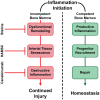The Aging Risk and Atherosclerosis: A Fresh Look at Arterial Homeostasis
- PMID: 29312440
- PMCID: PMC5735066
- DOI: 10.3389/fgene.2017.00216
The Aging Risk and Atherosclerosis: A Fresh Look at Arterial Homeostasis
Abstract
A considerable volume of research over the last decade has focused on understanding the fundamental mechanisms for the progression of atherosclerosis-the underlying cause for the vast majority of all cardiovascular (CVD)-related complications. Aging is the dominant risk factor for clinically significant atherosclerotic lesion formation, yet the heightened impact of aging on the disease is not accounted for by changes in traditional risk factors, such as lack of physical activity, smoking, hypertension, hyperlipidemia, or diabetes mellitus. This review will examine the pathological and biochemical processes of atherosclerotic plaque formation and growth, with particular focus on the aging risk vis-a-vis arterial homeostasis. Particular focus will be placed on the impact of a number of important contributors to arterial homeostasis including bone marrow (BM)-derived vascular progenitor cells, differential monocyte subpopulations, and the role of cellular senescence. Finally, this review will explore many critical observations in the way the disease process has been reassessed both by clinicians and researchers, and will highlight recent advances in this field that have provided a greater understanding of this aging-driven disease.
Keywords: aging; arterial homeostasis; atherosclerosis; bone marrow-derived vascular progenitor cells; cardiovascular disease; risk factors; vascular repair.
Figures



References
Publication types
LinkOut - more resources
Full Text Sources
Other Literature Sources

